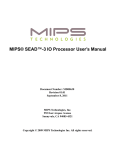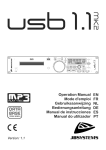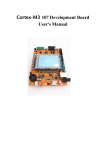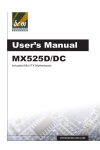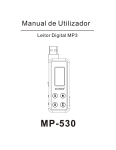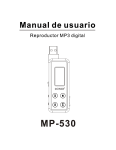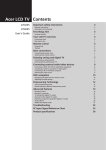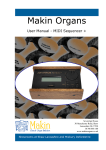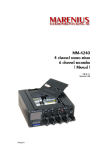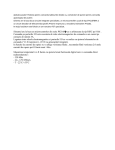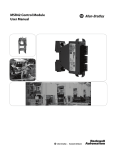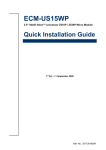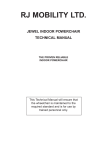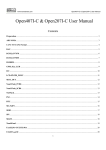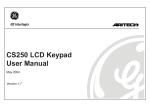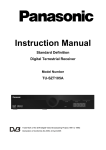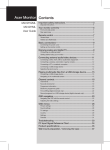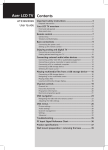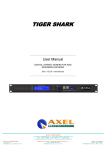Download User Manual - s3.amazonaws.com
Transcript
TX_SPMP3_220 Music Player User Manuel User Manual TX_SDMP3_220 Music Player Module Version: 4.1 Date: 2011/04/20 -1- TX_SPMP3_220 Music Player User Manuel Table of Content 1、Introduction of specifications and performances 2、Instruction of the diagram and pins 3、Statutes of file stored on storage media 4、Working mode instruction 5、Audio output instruction 6、Appendix 7、FAQ 8、Contact -2- TX_SPMP3_220 Music Player User Manuel 1. Introduction of specifications and performances TX-SDMP3-220 music player module (hereinafter referred to as MRM) is a device that can be used as a recorder and player. The storage media used is the reliable, exchangeable small SD card. The module can play for a long time; therefore, it is widely used in high definition sound needed places, such as the shopping mall, broadcasting, background music needed public, sound system of gaming devices, schools and etc. MRM uses MP3 music compression and reduction SoC, and guarantees the sound quality to meet the requirements of background music. Compare to the voice recording chip used in the embedded system, the MRM has advantages as following: 1.1. Nice sound quality. 48 KHz reached when playing, 16K sampling during recording, ADPCM coding. Other normal module cannot reach no higher than 8K which makes them is not suitable for the high-quality background music using or broadcasting. 1.2. It uses the standard memory card to store the music. After users edit the music in computer, the music can be written to the memory card through cheap card reader / writer instead of the expensive professional audio edit devices. MRM meets the requirements of flexibility and saves the cost as much as possible. 1.3. Flexible control. It can be controlled by serial ports or parallel ports. The parallel ports are used in excerpts playing and it can also be controlled by keys or MCU. It can be used in the fixed excerpt playing places such as the voice player and voice alarm. 1.4. 1Large capacity. The 32M SD card can record more than 2 hours. It is suitable for the long time recording. It can replace the tape-recording device completely and be used to record the live broadcasting music. The module supports 9 working modes. Working modes are saved in SD card, so user can choose the certain one freely. Following is the introduction of them; Mode 1: Serial port control + keys (optional) After the booting process, wait for the serial port commands. When get the command, interpret it. It can play the certain file in the certain folder in SD card. When make recording, user can specify the folder name and the file name, and also can use the automatically generated file name. During the playing, connect the keys to expect signal line of J2 can control the play operations, such as music selections and volume adjustments. -3- TX_SPMP3_220 Music Player User Manuel Mode 2: Serial port control + 8 GPIO control ports It is the same as the mode I. However, use the expect signal line of J2 as controllable GIPO port. It is equivalent that the mode expended 8 I/Os. Mode 3: Infrared wireless remote playback operation (optional) Infrared wireless control can be used. Under this way, when make recording, user only can use the automatically generated file name and save it in the specified folder. The module needs custom. The standard mould V2.2 doesn’t support this feature. Mode 4: 433M wireless remote playback operation; It is similar as mode 3. It uses the no directional radio to control the mould. Mode 5: Timing music playing Set the time through 8 GIPO ports of J2. Read the set data when open the player and countdown start. When timing time reached, start the module music playing operation. Mode 6: Direct excerpt play (8 excerpt signal lines. Maximum is 8 songs for option. Choose 1 of 8) Press any key of these 8 ports on J2 interface, the related songs will be played. Mode 7: Decoding excerpt play (8 excerpt signal lines, Maximum is 256 songs for option) Connect the 8 excerpt ports on J2 interface to the 8 DIP switch. Set the related songs through DIP switches. Hair low trigger pulse through the STB signal lines on J2 interface. Then, the module will choose corresponding song to play. -4- TX_SPMP3_220 Music Player User Manuel Mode 8: Auto play and recording (No needs of external parts) In this mode, check the terminals of J5’s jumper. If it is blank, play operation automatically. If J5 is in shorted condition, recording process is operated automatically. During the recording, the J5 is also under testing. When the short turn to blank, the recording will be stopped, and change to play operation automatically. Mode 9: Use four keys to achieve recording and playing. The control keys are connected with J2 pins. Module Specifications: Support whole series MPEG 1 & 2 audio layer 3 (ISO11172-3) coding; (including CBR fixed rate, VBR and ABR) (see appendix). Support WMA, WAV and MID files’ playing Use VS1003B as the chipset. Sound quality is excellent. DAC is 18. Dynamic range is 90dB. SNR is 85dB. Onboard column diode microphone. It can record automatically. Control the recording through serial ports making it more convenient. Support SD specification V1.0,including MMC card (1MB-2GB) produced by SanDisk, Toshiba, and Kingston, SD card, Mini SD card; support SD specification V1.1 including Micro SD card. Support FAT12 and FAT16 file system completely; Audio data should be arranged followed the agreed file names. The maximum of audio files in each folder can reach 65000. It can play hundreds of thousands of audio files in total. Multiple control modes, including direct excerpt choosing mode, loop mode, decoding excerpt mode, interface mode, remote control mode and etc. Auto play feature. It can play all audios in one folder automatically. There are no special requirements of file names. Find the audio files automatically, and no needs of external intervention. Encryption play features. It can play the audios which are simple different and encrypted. (Optional) It has 0-250 level smooth volume adjustment. 0 level is mute and 250 is the max. The interface can control the volume and checking the current volume. The keys’ step value is 16 and divided to 16 levels -5- TX_SPMP3_220 Music Player User Manuel Size: 57mm * 71.5mm (See dimensions); Input power can be DC 3.7v-9.1v; Support impedance 30 earphone output and external power amplifier There is one power indicator and three status indicators. During the playing, the certain indicator is shinning. Working status is straight front. Onboard standard 3.5mm power seat and earphone seat make the connection with system more efficiently. The connection also can be achieved by 2.54mm pins. Use on-board MCU with flash, and reserved the program download interface. User can make the second development (supply the development board to large volume customer only) Standard TDC20 pins (spacing 2.54mm or socket connection to connect. Module offers 256 byte EEPROM, no data lose when power off , and support to read and write of single byte of any byte unit through interface External MCU interface: both 3.3V and 5V interface level can be connected to the module by connecting lines directly. The I/O level meets the CMOS specifications Through serial port commands, it can read the contents of certain sector of specified file in folder on SD card. It uses the FAT buffer technology and the speed of reading large files is still very high. Serial port communication uses the interrupt mode. Though in the high speed MP3 playing mode, the host can query the working condition of modes by sending commands and get the responses. User can know whether the mode is working or not by sending query commands,as well as the playing speed. Use the hardware independence technology. In the module working mode1, both the interface commands control and the external keys connected through J2 control are effective. One TTL UART interface. Output baud rate is 9600 which can be used in testing and communication. Serial port commands support to read any sector in SD card and send the data to host to analysis. It makes file system testing and special features achieving easier, such as finding the SD card’s content and file system kinds anglicizing. Under working mode II, besides the music playing, the external 8 keys compatible to MSC-51 GPIO completely. They can read I0’s value and write the GPIO, and finish the control of peripheral. -6- TX_SPMP3_220 Music Player User Manuel 2、Instruction of the diagram and pins 2.1 Module Front View -7- TX_SPMP3_220 Music Player User Manuel 2.2 Module Back View -8- TX_SPMP3_220 Music Player User Manuel 2.3 Module Dimensions -9- TX_SPMP3_220 Music Player User Manuel 2.4 Module Interface Illustration 2.5 Interface signals features details Table - 10 - TX_SPMP3_220 Music Player User Manuel Name and definition of interfaces in the table: ,without external pull-up is 2.5V, external connection can increase to 5V. I- Signal input pin, input pin,the highest input power is 5V. O- Output pin P- Power pin A- Audio signal pin J2 Details No. Name Type Features 1 STB I play data latch signal, low level tigger 2 P20 I Input key 1, enlarge GPI00 3 P21 I Input key 2, enlarge GPI01 4 P22 I Input key 3, enlarge GPI02 5 P23 I Input key 4, enlarge GPI03 6 P24 I Input key 5, enlarge GPI04 7 P25 I Input key 6, enlarge GPI05 8 P26 I Input key 7, enlarge GPI06 9 P27 I Input key 8, enlarge GPI07 10 MCU_TXD O Interface command, TTL sends output signals 11 BUSY O Busy pin. Down at audio playing. Collector open-drain output, can be pull up to 5V 12 MCU_RXD I Interface command, TTL receives input signals 13 VCC_5V P/I 5V, external power input, be connected to J7 14 MCU_SCL O I2C communication, switching line. 15 VCC P/O Module’s 2.5V power regulator output. No need of vacant. 16 MCU_RST I Reset pin of modules’ hardware. effective, length 10mS 17 NC P Digital signal ground 18 20 、19、 GND - 11 - clock, record signal Lower TX_SPMP3_220 Music Player User Manuel J8 Signal Feature Details No. Name Type Features 1 LEFT A/O Left channel audio signal output 2 RIGHT A/O Right channel audio signal output 3 GBUF A/O Signal output common reference 4 AGND A/P Module signal ground 2.6 Module LED Features Details (self-checking and working mode): There are 3 status indicators LED and one power LED on MP3 play module. The features details are as following: D4: Power LED. When supply power normally to module and power output from the regulator, it keeps shinning. D1: SD card status LED. With power charged, the module will check the SD card itself. If is ok, the light keep shinning or it will be shut down. Please check the card inserting and the configuration is correct or not. During playing and recording, the lighting shinning shows there are operation on SD card sectors. The higher frequency of the operation, the higher frequency of shinning will be. D2: MCU working status LED. When MCU is waiting for the external trigger command, the light is shinning (it is upper to the working mode). There will be the specified agreement to the working different working mode when the MCU get the trigger command. Please check the definition of this light in each working mode. D3: Handshake signal line BUSY status LED. When the BUSY signal line is 0, the light is on to show the system is busy and can not accept the new commands. When BUSY is 1, the system is free, the light is off. During the POST, if the VS1003B failed, D3 shine 10 times and restart; if SD card initialization failed, D2 shines 10 times and restart; if there is error in file system initialization(besides the insert FAT12 or FAT16 card), D1 keeps shinning; if read profiles in SD card, D1 and D2 keep shinning at the same time. - 12 - TX_SPMP3_220 Music Player User Manuel 3、Storage Media files Statutes This module only use FAT12 and FAT 16 (FAT format in Windows)format SD card as the storage media of audio files. When formatting the media, please confirm the file system formats in PC. When MP3 module configures system, mainly is to search content in two folders on SD card. One is “config” and the other is “Music”. Set a text file named config.txt is necessary. The first letter (1-9) in this file shows the current working mode. Case is insensitive in file names and letters. Suggest capital the first letter. Folder “Music” is used to store the music to be broadcast. In the excerpt playing mode, the file names must be 000.mp3-256.mp3 3.1、Typical Application Storage Media files’ Storage Diagram is as following: - 13 - TX_SPMP3_220 Music Player User Manuel 3.2、Profile Content Diagram: - 14 - TX_SPMP3_220 Music Player User Manuel 4. Detailed Explanation of Working Modes 4.1 Mode 1 (Serial port control + keys): When the configuration character in profile is 1, the module is in Serial port port control + keys playing mode when powered up. Control the module by serial port commands or the keys connect to J2 terminal. User can specify any file in any folder to be single played, or all of the files in certain fold to be loop played as background music. During the playing, user can use stop/continue key to control the broadcasting, or stop it. Besides that, user can use serial port commands to do certain things. For example, read and write on-board EEPROM, and read the content in SD card files, and do data read on the SD card sectors. One of the special feature of this module is that it can record sound by sending the serial port commands. 4.11 Key features (serial port control playing) During the playing, if monitored the STB signal on J2 terminal is low, stop current playing. When it rose, turn to next playing or wait for the control command from interface During the music playing, D1 keeps shinning showing the module is reading data in SD card and send them to VS1003B to decoding and play. Stop playing when test the P27 has low level trigger pulse on J2 terminal for a short while and trig it again to go on playing. D2 turns on in pause and turns off in playing. P20 and P21 pins of J are the keys for the volume up and down. When the volume reaches limits, D2 turns on and turns off after release the keys. 4.12 Serial port communication protocol (serial ports control playing): Communication protocol: J2 terminal is the UART serial port that used to talk to the MP3 module. It can be connected to host MCU’s TXD, RXD directly. If it is needed to communicate with RS232 of PC, it has to be level changed from TTL to RS232 first. The baud rate of module communication is 9600bps, 1 start bit, 8 data bits, 1 stop bit and no parity. The protocol uses command and ACK format. The packet sent from host to MP3 module starts with 0x1B, 0x10. The ACK packet sent from MP3 module back to host MCU starts with 0x4F,0x4B or 0x45,0x52, depending on the status of execution of commands. - 15 - TX_SPMP3_220 Music Player User Manuel Format of command packet: 1B+10+XX (command number) + N (length of additional data) + N bytes (including end character 0x88) Supported command sets are as following : Command 0 4.1.1. Online command:1B 10 00 01 88 : Successful return 4F 4B 00 01 88 Return other contents or no return indicates the poor communication Command A0 4.1.5. Enter file folder (command A0) : 1B 10 A0 09 "12345678" 88 Command //represents entering the folder named 12345678 in the SD card root. Another example :1B 10 A0 09 B2 A5 B7 C5 D2 F4 C0 D6 88 shows enter the folder “music play” in the root. Red content in the middle is Chinese machine code. English letters use ASCII code. : 4F 4B 00 01 88 //enter the specified folder successfully Return 45 52 A0 01 88 // ender failed Command 80 4.1.6. Play audio file with specified name in current folder (0x80) Command: 1B 10 80 13 "12345678.MP3" 88 // shows playing the file named 12345678.MP3 in current folder. Another example :1B 10 80 08 30 30 31 2E 6D 70 33 88 shows playing 001.MP3 file in current folder - 16 - TX_SPMP3_220 Music Player User Manuel , Return: 4F 4B 00 01 88 show search the file successfully and started to play. During , , When the broadcasting finished, Busy raise up, D3 turns off,D1 turns on,which broadcasting MP3 module lowers the busy line, D3 light turns on D1 keeps shinning. indicates that the MP3 module can accept new command. Command 81 : 4.1.2.Pause 1B 10 81 01 88 : 。 Return 4F 4B 00 01 88, D2 turns on in pause Command 82 : 4.1.3. Continue to play 1B 10 82 01 88 : Return 4F 4B 00 01 88 Command 83 : 4.1.4.End current playing 1B 10 83 01 88 : Return 4F 4B 00 01 88 CommandA4 4.1.7.Volume control and checking(0xA4) : , Command 1B 10 A4 02 XX 88 // XX value is 0-250 0 is mute,250is the maximum Return: 4F 4B 56 01 88 //set the volume successfully, the current volume of return module is 0x56 (the higher value, the lower volume) Command 1B 10 A4 02 FF 88 checking the current volume value ( ) Return 4F 4B 06 01 88 show the current volume value is 06 - 17 - TX_SPMP3_220 Music Player User Manuel Command 90 4.1.8.Current play status checking(0x90) : Command 1B 10 90 01 88 Return 4F 4B XX 09 0002 0001 0000DC58 88 When XX is 80 shows under playing ,81 shows pause,00 shows the playing finished。 In loop playing, 0002 means the total number of songs is 2, 0001 means current playing is the first on. 0000DC58 shows the left sectors of current playing. Command C1 4.1.9.Loop play the folder(0XC1)- play all of the files in the folder as background music Command 1B 10 C1 04 ’XXXX’ 88 , X is the name of the played folder and the length is 1-8 For example, the command following means loop playing all of the files in the folder “music playing” 1B 10 C1 09 B2 A5 B7 C5 D2 F4 C0 D6 88 : Successful return 4F 4B 00 01 88 : Failed return 45 52 C1 01 88 Command C8 4.1.10.End folder loop playing(0XC8)-used to change the playing folder Command 1B 10 C8 01 88 Return 4F 4B 00 01 88 means end playing the folder successfully Command F0 4.1.11 Get basic information of current playing files (0xF0) Command 1B 10 F0 01 88 : Return 4F 4B F0 10 ABCDEFGHMP3 000089DE 88 0x10 shows the additional data number is 16. ABCDEFGHMP3 means the name of current broadcasting is “ABCDEFGH.MP3”. 000089DE means the total sectors of current - 18 - TX_SPMP3_220 Music Player User Manuel 。 playing file is0x000089DE Command E8 4.1.12 Write data onto module EEPROM(0XE8) , Command 1B 10 E8 03 AA DD 88 AA refers to the address and can be got 00-FF;DD means the data written into the address. : Return 4F 4B 00 01 88 module didn’t check whether the writing is successful or not. After wrote, use host to check by read EEPROM command. Command E9 4.1.13 Read data from module EEPROM(0XE9) , Command 1B 10 E9 02 AA 88 AA means address can get 00-FF; Return 4F 4B DD 01 88 DD means the data stored at AA address in the module Command E0 4.1.14 Open a file (0xE0) : Command 1B 10 E0 06 ‘HZK16’ 88 The above command mean opening the file named “HZK16” in current root. Only after the open, the reading can be preceded : Return:45 52 E0 01 88 means didn’t find the file. Return 4F 4B 00 01 88 means find the file in current root, and open successfully. Command E1 4.1.15 Read the content in file’s sectors (0xE1) : 1B 10 E1 09 12345678 0040 0020 88 Command The above example means reading the current open file sector and the start is 0x12345678. Offset in sector is 0x0040(64) Continuous read 0x0020 (32) bytes. Return 4F 4B E1 21 +32 data read from SD card +88 Base in 0x21means additional data’s length is 33. - 19 - TX_SPMP3_220 Music Player User Manuel Note: If the length of reading data is longer than 255 in sending, it can not show the correct high level of return pack’s additional data length. Only shows the low level content. 。 The maximum of reading data length is 0x0200(512 bytes). Over will be not effective. Start address can from 0x0000 to 0x01FF, however the length of start address +data can not longer than 0x0200, or the reading content is more than the capacity of 1sector, data goes invalid. Command F9 4.1.16 Send data to extended serial port (0xF9) : , , , Command 1B 10 F9 0X AA BB CC ……, FF 88 The interface extended from MP3 module uses fixed baud rate 9600 bps to send out data. Interface communication format is 1 start bit, 8 data bit, no parity and 1 end bit. 0X means additional data length is the one sent to interface plus 1. The maximum is 13. , , AA BB CC are the content sent to the module extended interface. The quantity is 1-12. 12 effective data can be sent in one time. Over, the module won’t send and return to error. Command F5 4.1.17 Read data on SD card sector (0xF5) : Command 1B 10 F5 05 AABBCCDD 88 AABBCCDD is four bits SD card absolute sector number, like usually MBR is at 00000000. Return: 4F 4B F5 EB 3C 90……5A A5 88, in total512+5=517 bytes. EB 3C 90……5A A5 is the content read in sector on SD card. 其中 XX is the error signal of reading Return: 45 52 XX 01 88 means the reading is failed. process. Command C2 4.1.18 Use MP3 module to do reset operation (0xC2) : Command 1B 10 C2 01 88 MP3 module does the reset operation when get this command. Reinitialize the hard/software related to MP3 module which is same as the power reset feature. - 20 - TX_SPMP3_220 Music Player User Manuel 4.1.19 Switch folder saved current recording data(0xA0) : 1B 10 A0 09 "12345678" 88 //shows enter the folder named 12345678 saved Command in the SD card root. : Another example 1B 10 A0 06 B2 A5 B7 C5 D2 F4 C0 D6 88 shows enter “music play” folder in the root. The red contend means Chinese character code. English letters use ASCII code. : 4F 4B 00 01 88 //success enter the set folder Return 45 52 A0 01 88 //enter failed Command 88 4.1.20 Start recording(0x88) : Command 1B 10 88 09 30 31 36 38 2E 77 61 76 88 09 means the length of additional is. 其中 30313638 2E 776176 means the record file name is 0168.wav. The name of record file can be set in the current folder. Before recoding, enter the commands list to the certain list. Module starts to record when get the command. During the recording, each sector sends F to host to show now it is working. If the first letter of command is “*”, the file name will be generated automatically. The file name is RECXXXXX.wav 。XXXXX is the number of recording files. It will find the MAX value of numbers, and plus 1 to this to name the new file. For example, following , command is start recording files 1B 10 88 04 2A 2E 2A 88 as the specify file name is , “*.*” it will generated automatically. ( 4.1.21 Stop recording 0x81 ) Command 1B 10 81 01 88 The module will stop recording when gets this command. In this situation, the samples - 21 - TX_SPMP3_220 Music Player User Manuel collected by microphone will not be saved on disk. This will save the room to record audio files in effective period. 4.1.22 To continue recording operation(0x82) Command 1B 10 82 01 88 The module will continue recoding when gets this command.sampling from the paused position and save them to the disk. There is no limitation of times of stop and continue. The file generated at last is the same one. Command 8B 4.1.23 End recording(0x8B/83) 1B 10 8B 01 88 1B 10 83 01 88 If the module gets any command in above two, the recording will be ended and generates the file name. Notes for recording: the recording supports FAT16 SD card only. Before the recording, please format the SD card to avoid stop caused by disk fragmentation. 4.2 Mode 2 Features Details(Serial ports control + GPIO control ports): When the configuration character is 2, the module is under the serial ports control + GPIO mode. The module has all of the serial port control features as module 1 but doesn’t have the key control features. The P20-P27 on J2 is the enlarged 8 bits GPIO of the module. The system default the configuration as “weak position”. At the same time, it adds two new available control commands as following: Command FA 4.2.1 Write extended GPIO(0XFA) Command :1B 10 FA 02 XX 88 - 22 - TX_SPMP3_220 Music Player User Manuel XX is the value of 8 bits output GPIO port, D0 is the pin of module P20 AND D7 is correspond to the pin of P27 : Return:45 52 FA 01 88 means the current module doesn’t support this command. Please Return 4F 4B 00 01 88 means success. check whether the module is under mode 2 or not. Command: FB 4.2.2、Read extended GPIO (0xFB) : Command 1B 10 FB 01 88 : Return 4F 4B XX 01 88 XX means the statue value of J2’s P20-P27 and D7 means P27. In mode 2, the extended GPIO defaults “weak position”. The push free input, enter only and the open-drain modes need to be costumed with manufacturer in advance. In mode 2, press the keys on STB of J2 can stop the current playing. 4.3 Mode 3 features details (infrared wireless control playing) (Optional) When the configuration character in profile is 3, the module is under the infrared wireless control playing mode. User can exchange last one / next one, turn up / down, pause/ go on the volume features wirelessly. The output signal from integration infrared signal receiver connects to pin 17 of terminal J2. When receive the signal, the module stops and finishes receiving. The transmitter chip supporting remote control defaulted by module is widely used TC9012 (or compatible chip). The serial port of control signal is constituted by boot code (9ms) + 0E + 0E + function code + features anti-code. When use infrared control, general using TC9012 remote controller frequency +- the back and the next to the corresponding song. The volume up and down key corresponds to the module volumes up and down. Mute and return key correspond to module’s pause/play key. When use the infrared control, local buttons are effective. See details in the introduction of mode 8. Do not use them in the same time to avoid interrupt. The module is designed after popular MP3 playing functions. If infrared control excerpt playing (like press key1 to play song 1 and so on), other special function’s development or add special remote control chips’ supporting, please contact the producer in advance. - 23 - TX_SPMP3_220 Music Player User Manuel 4.4 Mode 4 features details(wireless remote control playing) When the configuration character in profile is 3, the module is under the wireless control playing mode. It uses wireless controller. This control signal’s general uses PT2262 coding and 433M sending. No direction in receiving. The remote controlling can be in 100-300 m and can across the wall. The receiving of wireless remote control general uses the receiving module with decoding signal. Attention that the decoding chip uses PT2272 with suffix M (or compatible chip) to achieve. That means the output decoding signal is pulse. PT2272-M6 data bit output is decided by remote control sending. Just follow the following ( table to wiring. Note: PT2272-M6 ) defaults level as low. When the signal comes, it is high level pulse trigger. Not used features and connect the feature pin to ground directly (make it in no-trigger status). No. PT2272 output MP3 module Feature details 1 D0 P20 Volume up 2 D1 P21 Volume down 3 D2 P26 Back song 4 D3 P27 Pause / continue 5 D4 STB Next song The module is designed after popular MP3 playing functions. If wireless control excerpt playing (like press key1 to play song 1 and so on), other special function’s development or the analysis of development code support the wireless controller 8421BCD, please contact the producer in advance. 4.5 Mode5 features details ( timing music playing) When the configuration character in profile is 5, the module is under the timing music playing mode. It is equivalent to timing open. Loop playing all the music in the folder “Music”. Basic operation is the same as mode 8. P20-P27 connected to terminal J2 are module’s timer value configuration pins. P20-P23 is minute configuration pins and P24-P27 is hour configuration pins. ( ) ( ) Time length = basic unit is 5 minutes * P23-P20 +1 hour* P27—P24 Therefore, if minimum timer value is 0, the maximum is 15 hours 75 minutes. For example, P20-P27 is 1001 1000 means timer 1 hour 45minutes. For example, if timing start playing in 8 hours: P20-P27’s setting value is 0000 0001 When module is under working mode 5, read the timer length configuration value of pin J2’s P20-P27 after power on. Than, start the timing operation. Play all of the music files in - 24 - TX_SPMP3_220 Music Player User Manuel folder “music” in turn when reaches the timing point. In timing process, D1 and D2 are off. System will put audio decoding chip VS1003B and SD card in reset status to save power. D3 shines each second. It shows the system is working. Remove the power LED D4 to save more power. Module is designed follow the multifunction MP3 player. If you want to use shooter basic timer unit, such as 1 second, longer timer value, or do other operation at the same time when reach timing point(such as outputting replay signal open amplifier power) and etc, please contact the producer in advance. 4.6 Mode 6 features details(Direct excerpt play) When the configuration character in profile is 6, the module is under the direct except play mode. It can play 8 music files which have been recorded to storage media in maximum. Powered and self-checking finished, if everything is normal, D1 keeps shinning, D2 and D3 are off. Module monitors the P20-P27 of J2 terminal’s low level, and search file 001*.mp3-008*.mp3 in folder “Music” on storage media automatically. Find out the files corresponding to low level P20-P27 and start playing immediately. Priority from small to large is P20, P21…P27. In music playing D3 keeps shinning (busy signal) and low level which means the playing is undergoing. When playing finished, D3 turns off. If user triggers play, but the D2 shinning instead of D3, it means searching corresponding playing files failed. Please check the file name affectivity in SD card. If in playing process and STB triggers low level, end the current playing. Wait for the next playing operation of P20-P27. If there is low pin in P20-P27 when playing is finished, the corresponding music will be played continually. The file name need to be started with number and than it can be corresponding to excerpt trigger which makes files management and identification easier. For example, the file name is “002-wake-up music-****.mp3” in folder “music”, when P2.1 is test low level, the song will be played automatically. When use MCU or PLC to control the music playing module, the low level trigger pulse needs to bigger than 10mS to guarantee the trigger module effectively. The over short pulse is treated as interrupt and no responses. The module is designed follow common excerpt functions. If more direct excerpt choosing or other special functions (such as after chapter 1 and chapter 2 phase, play music 001), please contact the producer in advance. 4.7 Mode 7 features details(Decoding excerpt play) When the configuration character in profile is 7, the module is under the decoding except play mode. It can play 256 music files which have been recorded to storage media in maximum. Powered and self-checking finished, if everything is normal, D1 keeps shinning, D2 and - 25 - TX_SPMP3_220 Music Player User Manuel D3 are off. When the module tests the STB on J2 terminal is lowered, it will read the high/low level of pin P20-P27 first, than change binary to decimal numbers, start to search file 000*.mp3-256*.mp3 in folder “Music” on the storage media automatically, and find out the decimal 8 bits file name corresponding to the binary value. In this process, D2 shines one time to respond the trigger signal. When the STB signal increases, the music playing will start immediately. The D3 keeps shinning (Busy signal) in playing, and the output is low level. When the playing finished, D3 turns off. If the trigger play finished (STB signal lines from low to high), the D2 is shinning instead of D3, and it means searching corresponding playing files failed. Please check the file name affectivity in SD card. If in the playing process, trig the STB signal again, the current playing will be stopped. D3 turn off. When the STB release, begin to wait for the next trigger play. There is a pull-up resister in the excerpt signal pin. In vacant status, the internal testing value is 0. The module MCU testing value is 1 when connected to ground. P20 is the lowest level and the P27 is the highest. The file name need to be started with number than it can be corresponding to excerpt trigger which makes files management and identification easier. For example, the file named “006_work finished music _ go home.mp3” saved in folder “music”, when test the STB trigger signal and read the decoding value is 006, the music will be found and played automatically. When use MCU or PLC to control the music playing, the trigger pulse needs bigger than 10mS to guarantee the trigger module working effectively. The over short pulse is treated as interrupt and no responses. Mould is designed after common decoding function. If any special requirements (such as play total control switch input and excerpt selection Serial port II control), please contact the producer in advance. 4.8、Mode 8 features details(Auto play and recording) When the configuration character in profile is 8, the module is under the working mode 8. Powered and self-checking finished, it check the J5 jumper status, if it is short (plug in jumpers), it is in recording. When in recording, D1 and D2 are shining which means the system is recording. At that time, you can use the earphone seat to monitor and hear the content. If in the recording, up-plug the jumper on J5, which makes the J5 in open circuit, the recording will be stop automatically and turn to the playing. The number of each file is auto-increment. With power on, when J5 is in open circuit, the system is in auto play mode. It will find the all of the songs in the folder “music” which can be played automatically. Play it from the first one till the last. And then, return to the first one to play again. In the playing, if find the STB signal of J2 is low, it will stop the current playing. When the signal rises, it starts to play next one. In the playing, D3 (Busy signal light) is on, and D1 shinning. - 26 - TX_SPMP3_220 Music Player User Manuel In the playing, if find the low level trigger pulse on P27 of J2, stop the playing. D2 will be turned on. D1 off means the system stop and end the SD card reading. Trig P27 again, D2 will be off, and than start playing from the stopped point. P20 and P21 on J2 are turn up and turn down buttons in the playing. In the playing process, if keep the P20 at low level, the volume will be turned up. At the MAX volume, D2 turns on which means reached. Keeps the P21 at low level, the volume will be turned down. D2 will be on which means reach the minimum point. D2 is off when released the button. If the system is in pause status, keeps the P20 or P21 at low level also can control the volume. When the volume reaches the MAX or MIN, as D2 is on (means the system is stopped), D1 will show the volume is at the extreme. D1’s on means at the extreme and off means in the adjustable range. In working mode 8, interfaces control is effective, too. As the system is designed multi-functional, it has few shortcuts. If you have special requirements, please contact the manufacturer in advance. MP3 music playing module supports 3 status lights, 14 general input/output in max, and can be used in Human Machine Interface designing. 4.9、Mode 9 features details(Key control play and record) When the character in the profile is 9, the module is in working mode 9 with power on. 4 keys connect to J2 control the recording and playing. Power on and self-checking finished, D1 keeps on, D3 keeps on, wait for the key to start the recording/playing. D3 is the light for recording/playing status. D3’s on means the system is in playing status (power default). D3’s off means in recording status. P20 and P21 on the J2 stand for back one and next one. In the playing, you can switch on the songs. P26 on J2 is the switcher of recording and playing. When the module doesn’t play or record, this key is used to switch to make it achieve. On press, one switching. When the system is in playing status, D2 is light on, D3 off. When the module in playing or recording, press the key on P26, the current playing or recording will be ended. Key on P27 of J2 is the switcher of pause and on. When the system is waiting for playing / recording, press this key to start it. When the system is playing / recording, press this key to switch on pause / on. If the module in playing, press this key will stop it. Second press will start it. Switch like this. If the module is in recording, press this key to stop it and again to go on. - 27 - TX_SPMP3_220 Music Player User Manuel 5.Audio output instruction 5.1 The chipset used has built-in headphone amplifier. It can be connected directly to 16-32 Ohm stereo headphones. 5.2 Connect audio output to PA (the first way is recommend): 5.2.1 The first way of connecting: 5.2.2 The second way of connecting (check the power supply before using) - 28 - TX_SPMP3_220 Music Player User Manuel Notes: When amplifier board and MP3 module share the same low level power, you can not use the second way. For example, there is switching power supply of 12V and 5 V which share the same ground, you should use the first way to guarantee the potential of ground and etc. Module is simple designed. If you need module on- board audio isolation capacitance, or add power amplifier to drive the speaker directly please contact the manufacturer in advance. - 29 - TX_SPMP3_220 Music Player User Manuel 6. Appendix 6.1 File formats supported by MP3 module: This module can decode MPEG 1 and MPEG2 audio, level III (CBR+VBR+ABR); WMA 4.0/4.1/7/8/9 5-384kbps all stream files; WAV (PCM+IMA AD-PCM); Common MIDI/SP-MIDI files. 6.2 Module electrical features(Testing environment:5V DC regulated power supply) Specifications Storage temperature Working temperature Power DAC resolution Total harmonic distortion Dynamic range SNR (full scale signal) Separation Gain offset Frequency response Output signal peak Audio output load resistance Audio Output load capacitance Supply current, idle Power 128kbps@44KHz, 5v,32Ω, MAX volume Power, 350kbps@48KHz,5v, 32Ω, MAX volume Min -65 0 3.7 Typical 5 18 0.1 90 70 50 -0.5 -0.1 1,3 16 Max 150 70 9 0.3 75 1.5 30 - 30 - 0.5 0.1 1.7 Unit ℃ ℃ V Byte % DB DB DB DB DB Vpp Ω 100 PF 29 45 MA MA 54 MA TX_SPMP3_220 Music Player User Manuel VIL( input low power) VIH(input high power) VOL (output low power) VOH(output high power) P20-P27 trigger time TRST -0.5 1.5 1 1.75 0.2 2.1 1.8 20 10 - 31 - 1.3 5 0.3 V V V V ms ms TX_SPMP3_220 Music Player User Manuel 7、FAQ Q1: Why there is sonic boom in playing and the event location is same and disappear when SD card changed? A1: Because the SD card has “bad block” which damage the auto data and this will cause incorrect decoding. Use SD card of good quality. We suggest using the software MyDiskTest to test the “bad block”. If there is any, please change them instead of repairing. Q2: Why there is sonic boom when start playing but not in the playing? A2: Because there is an impulse responds caused by the DAC and external connected PA circuit when start playing. This is a kind of physical phenomena can not be avoided. Normally, it is not obvious. Suggest add 20-30 ms blank data when start the play in self-made MP3 audio to avoid wrong decoding. Normal MP3’s volume will increase step by step, so the impact is less. Q3: Why the noise “CZ..” comes out in the playing? A3: This is the AC sound interference. Please use the high quality power with EMC supression. At the same time, keep the module far away from ground to avoid the generation of electromagnetic induction Q4: Why there is no noise when use headphone playing while PA playing has? A4: Because the module has high SNR and low LN, the noise is hard to be found by headphone. When uses PA, the PA circuit introduces the noise of its own. Suggest use nice quality PA circuit and two-stage amplification, reduce the noise from before class, and avoid self-excitation caused by single-stage high magnification. When use PA playing, please use connect drawing mode 1 in introduction unit 6 to connect GND instead of GBUF. Use coupling capacitors around 100uF. Q5: Why does the voice become lower when connect the MP3 module to PA playing compared to connected to computer’s sound card? A5: Because this module uses DAC to output directly and the computer sound card has Op zoom. Suggest turn up the volume in interface mode, and two-stage amplifier circuit, to avoid self-excitation caused by single-stage high magnification. Q6: Does it support SD card larger than 2 GB? - 32 - TX_SPMP3_220 Music Player User Manuel A6: Until now, it only supports SD card or MMC card not larger than 2GB. Q7: Will too many files in SD card effect on the playing? A7: It won’t. However, it will need more time to switch music. Q8: About the connection between MP3 module and external user’s MCU, is it directly or crossly? A8: Do it crossly. The TXD of module means data output, it should be connected to RXD of user’s MCU. RXD of module means data in, it should be connected to TXD of the user’s MCU. Q9: How to initialize the MP3 module? A9: Generally speaking, the module is reliable and does not need the initialization. The module will test the SD card automatically when power on. After that, BUSY pin makes the low level to high. Then, the module can work normally. Or, you can press RST to output level more than 10ms with power supply, hard reset the module. Q10: How to check whether the playing is finished or not? A10: Test BUSY pin. When in playing, BUSY pin is low level; when stopped, the BUSY pin is high level. (Note: the pull-up resister is not included, level standard is 2.5V, and pull up to 5V through resister). Q11: How to use serial port mode to control MP3 module by external user’s MCU? A11: First, initialize the serial port interfaces in the user’s MCU, set the specifications such as baud rate and stop bit. The serial port Command is composited by bytes. Before send out the byte each time, you have to check the MCU register. Send out only after confirm it is free. The delay waiting is not needed for the bytes in the same command. After send the complete serial port command, suggest wait for the module until it back to “Ok” (attend to the capitalization). Timeout is 100ms. Resend the command if timeout. Next command can be sent when get the character “Ok”. Q12: How to treat the not used pins? Q12: Leave them floating. Q13: What should be paid attention when use 5V MCU to control MP3 module? A13: The module has protection circuit. Generally speaking, connect it directly to the module is ok.. However, avoid high current input to the module. - 33 - TX_SPMP3_220 Music Player User Manuel - 34 -


































